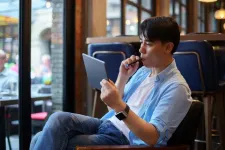(Press-News.org) LA JOLLA, CA — The brain is often referred to as a “black box”—one that’s difficult to peer inside and determine what’s happening at any given moment. This is part of the reason why it’s difficult to understand the complex interplay of molecules, cells and genes that underly neurological disorders. But a new CRISPR screen method developed at Scripps Research has the potential to uncover new therapeutic targets and treatments for these conditions.
The method, outlined in a study published in Cell on May 20, 2024, provides a way to rapidly examine the brain cell types linked to key developmental genes at a scale never done before—helping unravel the genetic and cellular drivers of different neurological diseases.
“We know that certain mutations in our genome can make us vulnerable or resilient towards different diseases, but which specific cell types are behind a disease? Which brain regions are susceptible to the genome mutations in those cells? These are the kinds of questions we're trying to answer,” says senior author Xin Jin, PhD, an assistant professor in the Department of Neuroscience at Scripps Research. “With this new technology, we want to build a more dynamic picture across brain region, across cell type, across the timing of disease development, and really start understanding how the disease happened—and how to design interventions.”
Thanks to over a decade’s efforts in human genetics, scientists have had access to long lists of genetic changes that contribute to a range of human illnesses, but knowing how a gene causes a disease is very different than knowing how to treat the illness itself. Every risk gene may impact one or several different cell types. Comprehending how those cell types—and even individual cells—impact a gene and affect disease progression is key to understanding how to ultimately treat that disease.
This is why Jin, along with the study’s first author, Xinhe Zheng, a PhD candidate and the Frank J. Dixon Graduate Fellow at Scripps Research, co-invented the new technique, named in vivo Perturb-seq. This method leverages CRISPR-Cas9 technology and a readout, single-cell transcriptomic analysis, to measure its impact on a cell: one cell at a time. Using CRISPR-Cas9, scientists can make precise changes to the genome during brain development, and then closely study how those changes affect individual cells using single-cell transcriptomic analysis—for thousands of cells in parallel.
“Our new system can measure individual cells’ response after genetic perturbations, meaning that we can paint a picture of whether certain cell types are more susceptible than others and react differently when a particular mutation happens,” Jin says.
Previously, the method for introducing the genetic perturbations into the brain tissue was very slow, often taking days or even weeks, which created suboptimal conditions for studying gene functions related to neurodevelopment. But Jin’s new screening method allows for rapid expression of perturbation agents in living cells within 48 hours—meaning scientists can quickly see how specific genes function in different types of cells in a very short amount of time.
The method also enables a level of scalability that was previously impossible—the research team was able to profile more than 30,000 cells in just one experiment, 10-20 times accelerated from the traditional approaches. In many of the brain regions they examined, such as the cerebellum, they were able to collect tens of thousands of cells that previous labeling methods could not reach.
In a pilot study using this new technology, Jin and her team’s interest was piqued when they saw a genetic perturbation elicit different effects when perturbed in different cell types. This is important because those impacted cell types are the sites of action for particular diseases or genetic variants. “Despite their smaller population representations, some low-abundant cell types may have a stronger impact than others by the genetic perturbation, and when we systematically look at other cell types across multiple genes, we see patterns. That’s why single-cell resolution—being able to study every cell and how each one behaves—can offer us a systematic view,” Jin says.
With her new technology in hand, Jin plans to apply it to better understand neuropsychiatric conditions and how certain cell types correspond with various brain regions. Moving forward, Jin says she’s excited to see this type of technology applied to additional cell types in other organs in the body to better understand a wide range of diseases in terms of tissue, development and aging.
//
This work and the researchers involved were supported by funding from the Dorris Scholar Award, the Frank J. Dixon Fellowship, the Mark Pearson Endowed Fellowship, the Stanley Center for Psychiatric Research at the Broad Institute of MIT and Harvard, the Simons Foundation Autism Research Initiative (grant SFARI #736613), the National Institute of Health (grant R01HG012819), the Impetus grant, the One Mind Rising Star Award, the Klingenstein-Simons Fellowship, the Mathers Foundation, the Baxter Young Investigator Award, the Larry L. Hillblom Foundation, the Scripps Collaborative Innovative Fund, the Chan Zuckerberg Initiative, the Conrad Prebys Foundation, the Astera Institute, and the James Fickle.
In addition to Jin, authors of the study, “Massively parallel in vivo Perturb-seq reveals cell type-1 specific transcriptional networks 2 in cortical development” are Xinhe Zheng, Boli Wu, Yuejia Liu, Grace S. Clarke, Abdullah Ashiq, Joshua Park, Jiwen Li, Zhilin Wang, Tianbo Qi and Yunxiao Zhang of Scripps Research; Sean K. Simmons, Kwanho Kim, and Joshua Z. Levin of the Broad Institute of MIT and Harvard; Liqi Tong, Qizhao Wang and Xiangmin Xu of the University of California, Irvine; Keerthi T. Rajamani, Rodrigo Muñoz-Castañeda, Shang Mu and Zhuhao Wu of Weill Cornell Medicine; and Zi Chao Ngiam, Naoto Ohte and Carina Hanashima of Waseda University.
About Scripps Research
Scripps Research is an independent, nonprofit biomedical institute ranked one of the most influential in the world for its impact on innovation by Nature Index. We are advancing human health through profound discoveries that address pressing medical concerns around the globe. Our drug discovery and development division, Calibr-Skaggs, works hand-in-hand with scientists across disciplines to bring new medicines to patients as quickly and efficiently as possible, while teams at Scripps Research Translational Institute harness genomics, digital medicine and cutting-edge informatics to understand individual health and render more effective healthcare. Scripps Research also trains the next generation of leading scientists at our Skaggs Graduate School, consistently named among the top 10 US programs for chemistry and biological sciences. Learn more at www.scripps.edu.
END
New method to reveal what drives brain diseases
Scripps Research scientists develop CRISPR screen technology to determine disease mechanism from tissues with accelerated speed.
2024-05-20
ELSE PRESS RELEASES FROM THIS DATE:
AI chips could get a sense of time
2024-05-20
Image
Artificial neural networks may soon be able to process time-dependent information, such as audio and video data, more efficiently. The first memristor with a 'relaxation time' that can be tuned is reported today in Nature Electronics, in a study led by the University of Michigan.
Memristors, electrical components that store information in their electrical resistance, could reduce AI's energy needs by about a factor of 90 compared to today's graphical processing units. Already, AI is projected to account for about half a percent of the world's total electricity ...
PARC model of care associated with fewer deaths among veterans post-ICU
2024-05-20
EMBARGOED UNTIL: 10:15 a.m. PT, Monday, May 20, 2024
PARC MODEL OF CARE ASSOCIATED WITH FEWER DEATHS AMONG VETERANS POST-ICU
Session: B18 – Bridging Gaps to Improve Long-Term Outcomes
The Post-Acute Recovery Center: A Telehealth Care Model to Improve Patient-Centered Outcomes for High-Risk Survivors of Critical Illness
Date and Time: Monday, May 20, 2024, 10:15 a.m. PT
Location: San Diego Convention Center, Room 32A-B (Upper Level)
ATS 2024, San Diego – Research presented at the ATS 2024 International Conference demonstrates that veterans who received ...
Department of Energy announces $6 million for isotope R&D
2024-05-20
WASHINGTON, D.C. - Today, the U.S. Department of Energy (DOE) announced $6 million in funding for 12 awards across eight efforts to advance research in isotope enrichment, targetry, and separations. This funding is part of a key federal program that produces critical isotopes otherwise unavailable or in short supply in the U.S.
Isotopes, or variations of the same elements that have the same number of protons but different numbers of neutrons, have unique properties that make them powerful in medical diagnostic and treatment applications. They are also essential for applications in quantum information science, nuclear power, national security, and more.
“These ...
World leaders still need to wake up to AI risks, say leading experts ahead of AI Safety Summit
2024-05-20
UNDER EMBARGO UNTIL 19:00 BST / 14:00 ET MONDAY 20 MAY 2024.
World leaders still need to wake up to AI risks, say leading experts ahead of AI Safety Summit
More information, including a copy of the paper, can be found online at the Science press package at https://www.eurekalert.org/press/scipak/, or can be requested from scipak@aaas.org
Leading AI scientists are calling for stronger action on AI risks from world leaders, warning that progress has been insufficient since the first AI Safety Summit in Bletchley Park six months ago.
Then, the world’s leaders pledged to govern AI responsibly. However, as the second AI Safety Summit in Seoul ...
*FREE* Managing extreme AI risks amidst rapid technological development
2024-05-20
Although researchers have warned of the extreme risks posed by rapidly developing artificial intelligence (AI) technologies, there is a lack of consensus about how to manage them. In a Policy Forum, Yoshua Bengio and colleagues examine the risks of advancing AI technologies – from the social and economic impacts, malicious uses, and the possible loss of human control over autonomous AI systems – and recommend directions for proactive and adaptive governance to mitigate them. They call on major technology companies and public funders to invest more – at least one-third of their budgets – into assessing and ...
Advancing 3D mapping with tandem dual-antenna SAR interferometry
2024-05-20
The new Tandem Dual-Antenna Spaceborne Synthetic Aperture Radar (SAR) Interferometry (TDA-InSAR) system, addresses the limitations of current spaceborne Synthetic Aperture Radar (SAR) systems by providing a more reliable and efficient method for 3D surface mapping. The system's innovative design allows for single-pass acquisitions, significantly reducing the time required for data collection and enhancing the precision of 3D reconstructions in various terrains, including built-up areas and vegetation canopies.
Synthetic Aperture Radar (SAR) interferometry (InSAR) is a powerful tool for producing high-resolution topographic maps. However, traditional InSAR techniques face ...
Mount Sinai launches Center for Healthcare Readiness to strengthen practice and partnerships in public health emergency response
2024-05-20
The Icahn School of Medicine at Mount Sinai announced the launch of its new Center for Healthcare Readiness, bringing together a diverse team of academic and operational experts to strengthen the Mount Sinai Health System’s strategies and the U.S. health care sector’s capacity to prepare for and respond to any large-scale public health emergency.
The Center will work with both Mount Sinai’s own resources, and public and private partners at the local, regional, and federal levels, to pursue strategies in research, advocacy, innovation, and collaboration to plan ...
Study sheds light on bacteria associated with pre-term birth
2024-05-20
Researchers from North Carolina State University have found that multiple species of Gardnerella, bacteria sometimes associated with bacterial vaginosis (BV) and pre-term birth, can coexist in the same vaginal microbiome. The findings add to the emerging picture of Gardnerella’s effects on human health.
Gardnerella is a group of anaerobic bacteria that are commonly found in the vaginal microbiome. Higher levels of the bacteria are a signature of BV and associated with higher risk of pre-term birth, ...
Evolving market dynamics foster consumer inattention that can lead to risky purchases
2024-05-20
CORVALLIS, Ore. – Researchers have developed a new theory of how changing market conditions can lead large numbers of otherwise cautious consumers to buy risky products such as subprime mortgages, cryptocurrency or even cosmetic surgery procedures.
These changes can occur in categories of products that are generally low risk when they enter the market. As demand increases, more companies may enter the market and try to attract consumers with lower priced versions of the product that carry more risk. If the negative effects of that risk are not immediately noticeable, the market can evolve to keep consumers ignorant of the risks, said Michelle Barnhart, an associate professor ...
Ex-cigarette smokers who vape may be at higher risk for lung cancer
2024-05-20
EMBARGOED UNTIL: 9:15 a.m. PT, May 20, 2024
Session: B20 – Lung Screening: One Size Does Not Fit All
Association of Electronic Cigarette Use After Conventional Smoking Cessation with Lung Cancer Risk: A Nationwide Cohort Study
Date and Time: Monday, May 20, 2024, 9:15 a.m. PT
Location: San Diego Convention Center, Room 30A-B (Upper Level)
ATS 2024, San Diego – Former cigarette smokers who use e-cigarettes or vaping devices may be at higher risk for lung cancer than those who don’t ...
LAST 30 PRESS RELEASES:
How talking slows eye movements behind the wheel
The Ceramic Society of Japan’s Oxoate Ceramics Research Association launches new international book project
Heart-brain connection: international study reveals the role of the vagus nerve in keeping the heart young
Researchers identify Rb1 as a predictive biomarker for a new therapeutic strategy in some breast cancers
Survey reveals ethical gaps slowing AI adoption in pediatric surgery
Stimulant ADHD medications work differently than thought
AI overestimates how smart people are, according to HSE economists
HSE researchers create genome-wide map of quadruplexes
Scientists boost cell "powerhouses" to burn more calories
Automatic label checking: The missing step in making reliable medical AI
Low daily alcohol intake linked to 50% heightened mouth cancer risk in India
American Meteorological Society announces Rick Spinrad as 2026 President-Elect
Biomass-based carbon capture spotlighted in newly released global climate webinar recording
Illuminating invisible nano pollutants: advanced bioimaging tracks the full journey of emerging nanoscale contaminants in living systems
How does age affect recovery from spinal cord injury?
Novel AI tool offers prognosis for patients with head and neck cancer
Fathers’ microplastic exposure tied to their children’s metabolic problems
Research validates laboratory model for studying high-grade serous ovarian cancer
SIR 2026 delivers transformative breakthroughs in minimally invasive medicine to improve patient care
Stem Cell Reports most downloaded papers of 2025 highlight the breadth and impact of stem cell research
Oxford-led study estimates NHS spends around 3% of its primary and secondary care budget on the health impacts of heat and cold in England
A researcher’s long quest leads to a smart composite breakthrough
Urban wild bees act as “microbial sensors” of city health.
New study finds where you live affects recovery after a hip fracture
Forecasting the impact of fully automated vehicle adoption on US road traffic injuries
Alcohol-related hospitalizations from 2016 to 2022
Semaglutide and hospitalizations in patients with obesity and established cardiovascular disease
Researchers ‘listen in’ to embryo-mother interactions during implantation using a culture system replicating the womb lining
How changing your diet could help save the world
How to make AI truly scalable and reliable for real-time traffic assignment?
[Press-News.org] New method to reveal what drives brain diseasesScripps Research scientists develop CRISPR screen technology to determine disease mechanism from tissues with accelerated speed.



